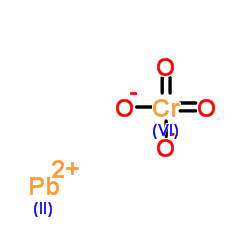Lead(2+) dioxido(dioxo)chromium

Lead(2+) dioxido(dioxo)chromium structure
|
Common Name | Lead(2+) dioxido(dioxo)chromium | ||
|---|---|---|---|---|
| CAS Number | 7758-97-6 | Molecular Weight | 323.19400 | |
| Density | 6,3 g/cm3 | Boiling Point | N/A | |
| Molecular Formula | CrO4Pb | Melting Point | 844°C | |
| MSDS | Chinese USA | Flash Point | N/A | |
| Symbol |


GHS08, GHS09 |
Signal Word | Danger | |
| Name | lead chromate |
|---|---|
| Synonym | More Synonyms |
| Density | 6,3 g/cm3 |
|---|---|
| Melting Point | 844°C |
| Molecular Formula | CrO4Pb |
| Molecular Weight | 323.19400 |
| Exact Mass | 323.89700 |
| PSA | 80.26000 |
| Stability | Stable. Reacts violently with ferric ferrocyanide. |
| Water Solubility | Insoluble. |
CHEMICAL IDENTIFICATION
HEALTH HAZARD DATAACUTE TOXICITY DATA
MUTATION DATA
|
| Symbol |


GHS08, GHS09 |
|---|---|
| Signal Word | Danger |
| Hazard Statements | H350-H360Df-H373-H410 |
| Precautionary Statements | P201-P260-P280-P308 + P313 |
| Hazard Codes | T:Toxic;N:Dangerousfortheenvironment; |
| Risk Phrases | R33;R40;R50/53;R61;R62 |
| Safety Phrases | S53-S45-S60-S61 |
| RIDADR | UN 3077 9/PG 3 |
| WGK Germany | 3 |
| RTECS | GB2975000 |
| Packaging Group | III |
| Hazard Class | 6.1 |
|
Comparison of two particulate hexavalent chromium compounds: Barium chromate is more genotoxic than lead chromate in human lung cells.
Environ. Mol. Mutagen. 44(2) , 156-62, (2004) Particulate hexavalent chromium [Cr(VI)] compounds are well-established human lung carcinogens. However, their carcinogenic mechanisms are poorly understood as most investigators have used soluble Cr(... |
|
|
Particulate and soluble hexavalent chromium are cytotoxic and genotoxic to human lung epithelial cells.
Mutat. Res. 610(1-2) , 2-7, (2006) Particulate hexavalent chromium (Cr(VI)) is a well-established human lung carcinogen. It is currently a major public health concern, there is widespread exposure to it in occupational settings and to ... |
|
|
Homologous recombination repair protects against particulate chromate-induced chromosome instability in Chinese hamster cells.
Mutat. Res. 625(1-2) , 145-54, (2007) Particulate hexavalent chromium [Cr(VI)] compounds are well-established human carcinogens. Cr(VI)-induced tumors are characterized by chromosomal instability (CIN); however, the mechanisms of this eff... |
| EINECS 231-846-0 |
| Lead(2+) dioxido(dioxo)chromium |
| Lead(II) chromate |
| Lead chromate |
| MFCD00011158 |
| Chromium, diolatodioxo-, lead(2+) salt (1:1) |

